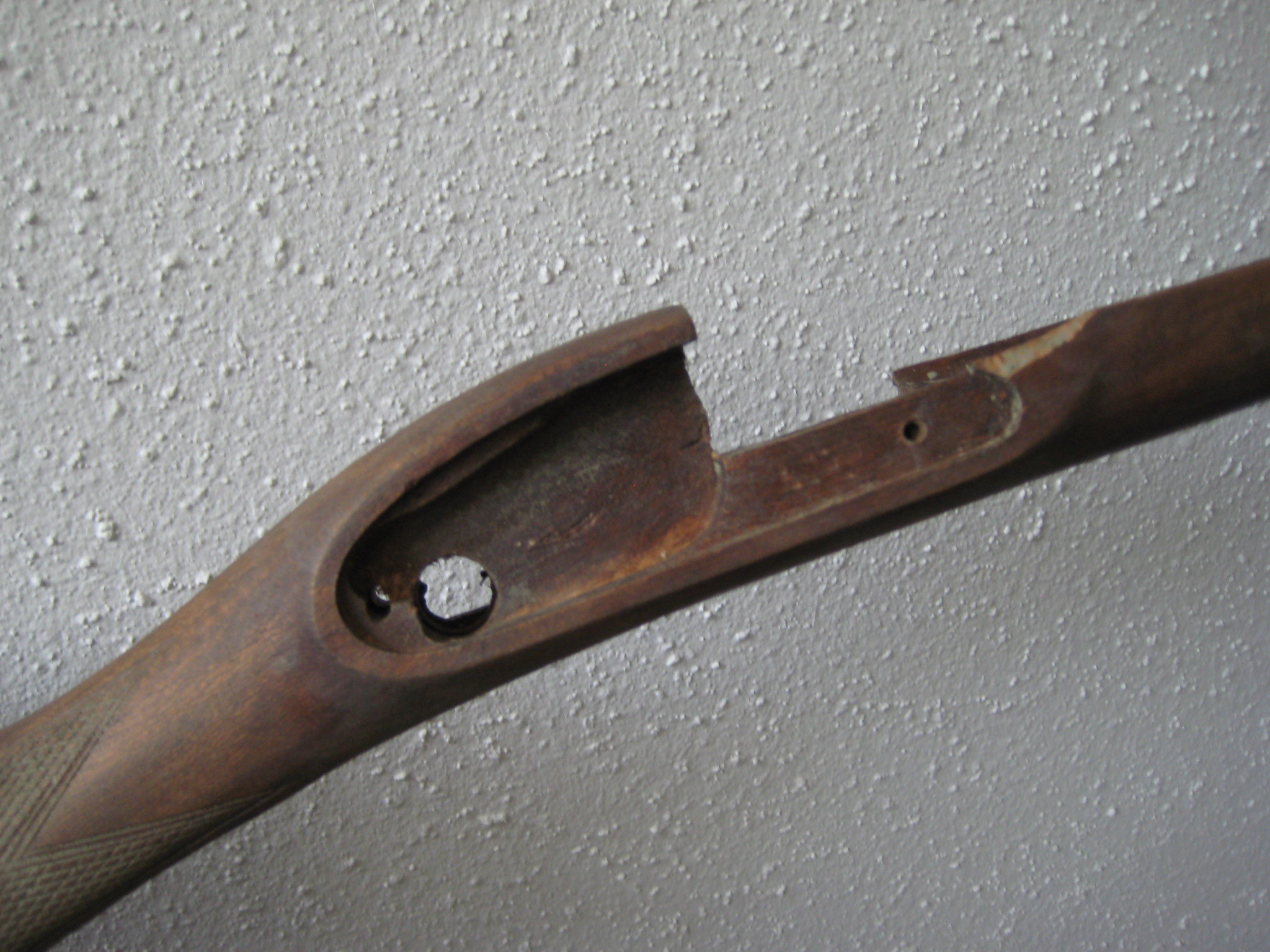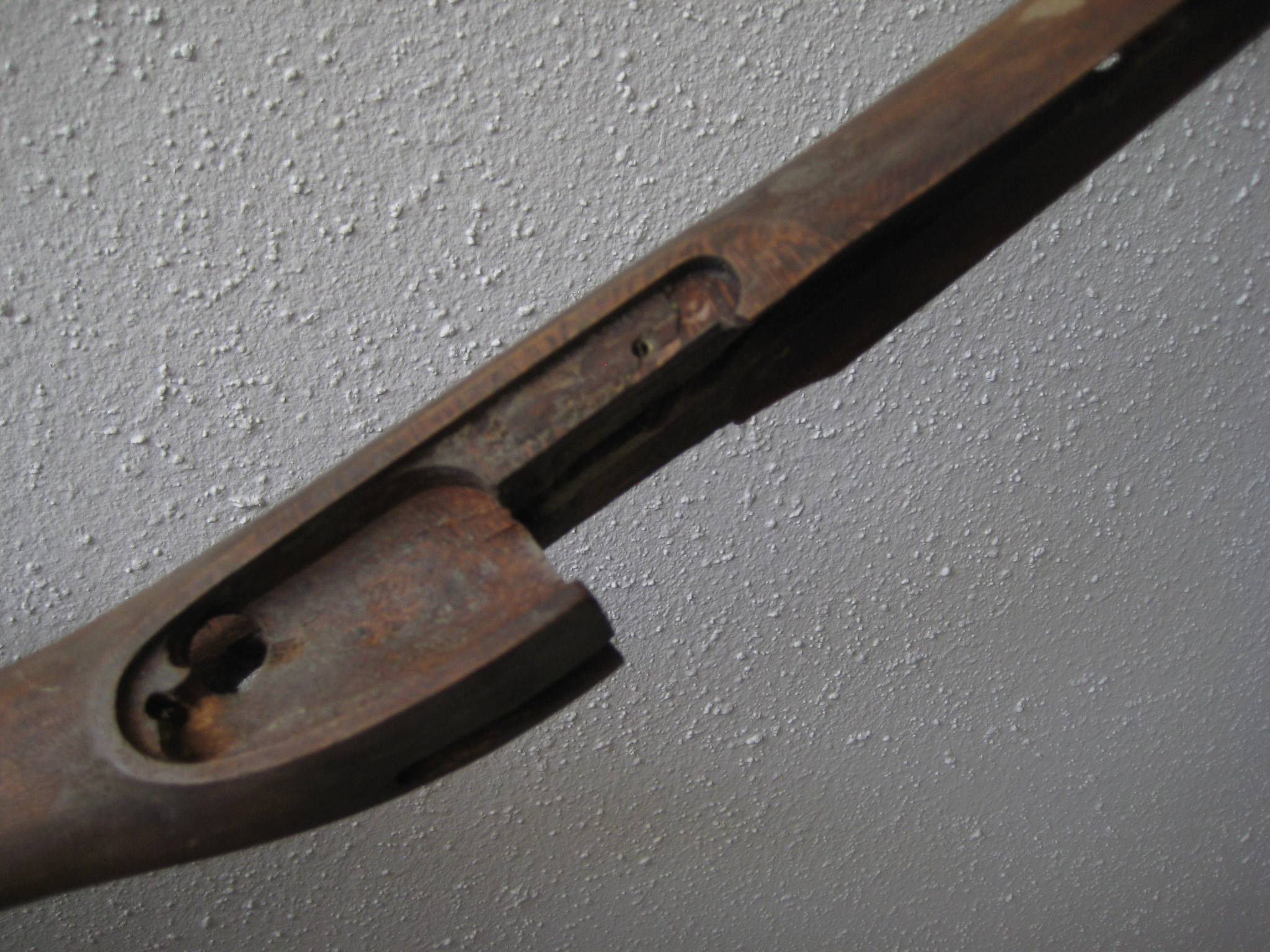I recently acquired a muzzleloading coach shotgun with a halfstock design. I found a hairline crack from the bottom of the bolster toward the trigger at a 25-degree angle below horizontal. The stock has this crack on both sides. I intend to glue this and see how well that works. There is insufficient wood to dowel this crack (more on this below).
bolster = the L-shaped cut in the top of the stock where the back of the breech rests (the tang is atop the bolster).
Problem: there seems to be no significant single continuous section of wood running from forearm to grip that would protect against a sideways, downward or upward force (e.g., using the shotgun as an oar or as an assist while standing up - yes, foolish things to do, but here for illustration). So one could grasp the forearm in one hand, the grip in the other and quite easily snap the stock into two pieces. This seems likely whether the gun is disassembled or assembled.
The various inlettings for the locks, trigger, breech and barrel, and ramrod each remove a different cross-section of the stock. Consequently very little (if any) of the stock's cross-section runs the full length from forearm to grip. The weakest part of this structure is at the bolster, where the bolster itself, the trigger inletting and the lock inletting cut deepest, leaving little core wood structure to form a "spine" to support the stock.
I examined the design of the double shotgun in Brockway's "Recreating the Double Barrel Muzzleloading Shotgun" and several other designs. They appear similarly weak in this regard. I do not know what stresses are put on the stock by shooting the shotgun and I suspect that, even were a shotgun handled carefully, the stress of shooting with such a stock might also eventually crack it.
It appears that such a design relies greatly, even unduly, on the strength of the wood used. Is it not an uncommon occurrence to have a double shotgun stock split with a crack originating in or near the bolster as has happened with this shotgun? If so, What permanent repair would be possible?
Or is there something that I am missing here? Does the shotgun gain significant additional rigidity or strength from the lock plates when they are installed? How might one strengthen the stock in this area? Is there a better or "best practices" design that someone might suggest, were I to buy or make a new stock (this would likely require new locks and trigger mechanism).
bolster = the L-shaped cut in the top of the stock where the back of the breech rests (the tang is atop the bolster).
Problem: there seems to be no significant single continuous section of wood running from forearm to grip that would protect against a sideways, downward or upward force (e.g., using the shotgun as an oar or as an assist while standing up - yes, foolish things to do, but here for illustration). So one could grasp the forearm in one hand, the grip in the other and quite easily snap the stock into two pieces. This seems likely whether the gun is disassembled or assembled.
The various inlettings for the locks, trigger, breech and barrel, and ramrod each remove a different cross-section of the stock. Consequently very little (if any) of the stock's cross-section runs the full length from forearm to grip. The weakest part of this structure is at the bolster, where the bolster itself, the trigger inletting and the lock inletting cut deepest, leaving little core wood structure to form a "spine" to support the stock.
I examined the design of the double shotgun in Brockway's "Recreating the Double Barrel Muzzleloading Shotgun" and several other designs. They appear similarly weak in this regard. I do not know what stresses are put on the stock by shooting the shotgun and I suspect that, even were a shotgun handled carefully, the stress of shooting with such a stock might also eventually crack it.
It appears that such a design relies greatly, even unduly, on the strength of the wood used. Is it not an uncommon occurrence to have a double shotgun stock split with a crack originating in or near the bolster as has happened with this shotgun? If so, What permanent repair would be possible?
Or is there something that I am missing here? Does the shotgun gain significant additional rigidity or strength from the lock plates when they are installed? How might one strengthen the stock in this area? Is there a better or "best practices" design that someone might suggest, were I to buy or make a new stock (this would likely require new locks and trigger mechanism).






